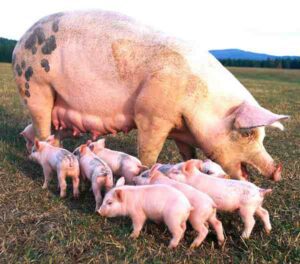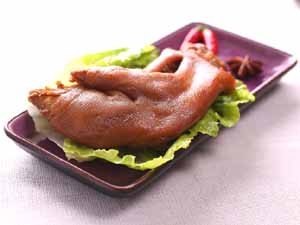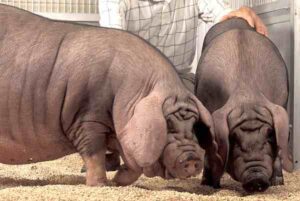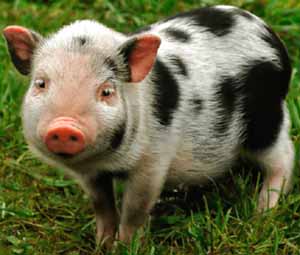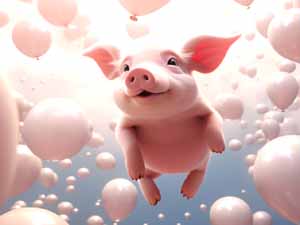The Hampshire pig is a breed of domestic pig from United Kingdom. It is easily characterized by it’s erect ears and black body. It is probably the oldest American pig breed. According to the American National Swine Registry, it is the fourth ‘most recorded breed‘ of pigs in the United States.
The breed is believed to have derived from the English breeds which were found in the northern England and Scotland. The breed is thought to have been brought to America from Hampshire, England between 1827 and 1839. The pigs remaining in Hampshire of England developed later into the Wessex Saddleback.
The Wessex Saddleback pig breed is similar in coloration to the Hampshire pig, but with flop ears and they are kept largely for foraging in the forest.
Origin and History of Hampshire Pig
The Hampshire is a common pig breed, and it comes from the United States. It is popular in it’s native area, and people started breeding these pigs a long time ago, in the 1800s. The breed was called as Hampshire Hogs by the residents of Hampshire. Read more information about the breed below.
Characteristics
The Hampshire pig is a medium sized breed of pig. It has erect ears and black body, with a whitish band around the middle, covering the front legs. Body of the animal is well built with long legs and noses, making the breed popular for meat production.

Size And Weight
Average body height of the mature pigs is typically between 71 to 81 centimeters at the shoulder. The mature Hampshire boars on average weight around 300 kg. And average live body weight of the mature sows is about 250 kg.
Housing Requirements
Arranging a very good and secure housing system for your pigs is very important. So, try to build a comfortable house for your pigs. A good house will help the animals to stay healthy and will also keep them free from adverse weather conditions.
Ensure good ventilation system inside the house and also ensure flow of enough clean air and enough light inside the house. And try to keep separate room for the breeding boar, pregnant and nursing sow.
Dietary Requirements
Feeding the pigs with very good quality and nutritious food is another important part of commercial pig farming business. So, always try to feed your pigs with enough good and nutritious food. Good quality food helps the pigs to stay healthy and grow faster.
Actually, you can feed your pigs with almost everything. But you have to provide them special food for commercial production. Ready-made commercial food for pigs is available in the market.
You can also make their food with low cost and easily available ingredients such as oats, grains, maize, wheat, rice, sorghum etc. Along with high quality foods, also ensure the availability of enough clean and fresh water throughout the day.
Reproduction/Breeding
The Hampshire pigs are naturally very good breeders, just like many other domestic pig breeds. They will breed easily and produce piglets if you keep good ratio of male and female pigs in your farm.
Heat period of a sow lasts for 2 to 3 days. A lactating sow become ready for breeding again 2-10 days after weaning. Gestation period of pigs is not more than 115 days.
Temperament
Hampshire pigs are well-known for being calm and gentle. They have a friendly temperament and they are easy to handle and take care of. They are not usually aggressive or nervous.
Health
Hampshire pigs are generally healthy animals. They do well when they are given good food, clean water, and a comfortable place to live. Ensure that they are getting regular health check-ups from a veterinarian. And doing this will help them to keep them healthy.
Watch for signs of illness and give them medicine when needed. Always try to keep their living area clean, and doing this will help to prevent diseases and other health problems.
Caring
These pigs are naturally very strong and hardy, and they generally require less caring and other management. Although, taking additional care will help the animals to stay healthy and grow better.
So, try to ensure hygiene system inside the house. This will help the animals to stay free from all types of health hazard and diseases. Feed them nutritious food and clean water, and monitor their health on a regular basis.
Popularity and Price
Hampshire pigs are quite popular (especially in it’s native area) because they are good for making tasty meat. Many people like to eat pork from Hampshire pigs. Although it’s very tough for us to tell the exact price. You can expect the average price of a Hampshire piglets ranging from $100 to $300. The young breeding stock will cost you between $300 to $800. And average price of the mature sows and boars typically range from $500 to sometimes over $1000 (depending on their lineage and quality). You can directly contact with a breeder in your area to learn more about the current price.
Uses
Hampshire pigs are used mainly for their meat. Their meat is delicious and often used for making yummy food like bacon and pork chops. They are also used for breeding purpose (for improving other breeds). Some people even keep Hampshire pigs as pets, because they are friendly and it’s very easy to take care of them.
Pros and Cons of Hampshire Pigs
Like many other pig breeds, these pigs also have numerous advantages and disadvantages. Here we are trying to list some pros and cons of Hampshire pigs:
Pros:
- High quality meat
- High Meat Yield
- Fast growth
- They can adapt to various climates and environments.
- Friendly temperament
Cons:
- Lack of disease resistance
- Space and feeding requirements
- Higher initial costs
- Breeding challenges
- Market competition
Special Notes
The Hampshire pig is known and noted for being rapid growers and well-muscled. Even it grow faster than the Yorkshires, but do not grow as fast as many cross-breeds.
It exhibit good carcass quality and very good for using for meat production. The sows are excellent mothers, and have extra longevity.
The animals are usually of good temperament. Review full breed profile of the Hampshire pig in the following chart.
| Breed Name | Hampshire | |
| Other Name | Hampshire Hog | |
| Special Notes | Rapid growers, well-muscled, good carcass quality, sows are excellent mothers, good temperament | |
| Breed Size | Medium | |
| Boars | Around 300 kg | |
| Sows | Around 250 kg | |
| Climate Tolerance | All climates | |
| Color | Black and white | |
| Rarity | Available | |
| Country/Place of Origin | United Kingdom |
Frequently Asked Questions (FAQs)
Many people ask questions about Hampshire pigs. Here we are trying to list the most common questions about this pig breed, and trying to answer them. Hope you will find your answer. Don’t hesitate to ask us if you have more questions.
What is the Hampshire pig known for?
The Hampshire breed is known for it’s excellent meat production. It has the reputation of being the leanest of the North American pig breeds. The breed is also used extensively as the sire of cross bred pigs for the pork and manufacturing markets in the USA and many other countries.
How much does a Hampshire pig cost?
Depends on numerous factors. Average price can vary from just $100 to $1000 or even more. Exact price depends on numerous factors such as age, size, breeder and their broodline.
How long do Hampshire pig live?
Average lifespan of these pigs is around 12 years. Although, in commercial farms, they are marketed within their 8-12 months of age or even earlier.
How big do Hampshire pigs get?
The Hampshire is a large pig breed. Average live body weight of the mature boars is around 300 kg, and average live body weight of the sows is around 250 kg.
What makes Hampshire pigs unique?
They have erect ears which is black and stick straight up. Their head is of medium-size and their eyes are quite small.
Are Hampshire pigs friendly?
Yes, they are very friendly, docile and clean.
How much space does a Hampshire pig need?
For commercial production, a Hampshire need around 8 square feet of space.
Where did Hampshire pigs originate from?
United Kingdom. The breed is believed to have derived from the English breeds which were found in the northern England and Scotland. The breed is thought to have been brought to America from Hampshire, England between 1827 and 1839.
Where do Hampshire pigs live?
They are native in southern Scotland and Northern England. But today, they are also available in many countries around the world and very popular.
When did Hampshire pigs come to America?
The breed is thought to have been brought to America from Hampshire, England between 1827 and 1839.
How do you feed Hampshire pigs?
These pig’s diet must include with grains and protein supplements. Diet will vary upon age and weight of the pig. But on an average, a mature Hampshire eat about 2-3 kg of food per day.
Are Hampshire pigs a heritage breed?
No it is not a heritage breed. It is believed to have derived from English breed between 1827 and 1839.
What does a Hampshire pig look like?
The Hampshire breed is black with a white belt extending over the front shoulders and down the front legs and they have erect ears.
What is the scientific name for a Hampshire pig?
The scientific name for a Hampshire pig is ‘Sus scrofa domesticus‘.
How fast do Hampshire pigs grow?
They generally grow faster and become ready for marketing between their 6 and 8 months of age.

